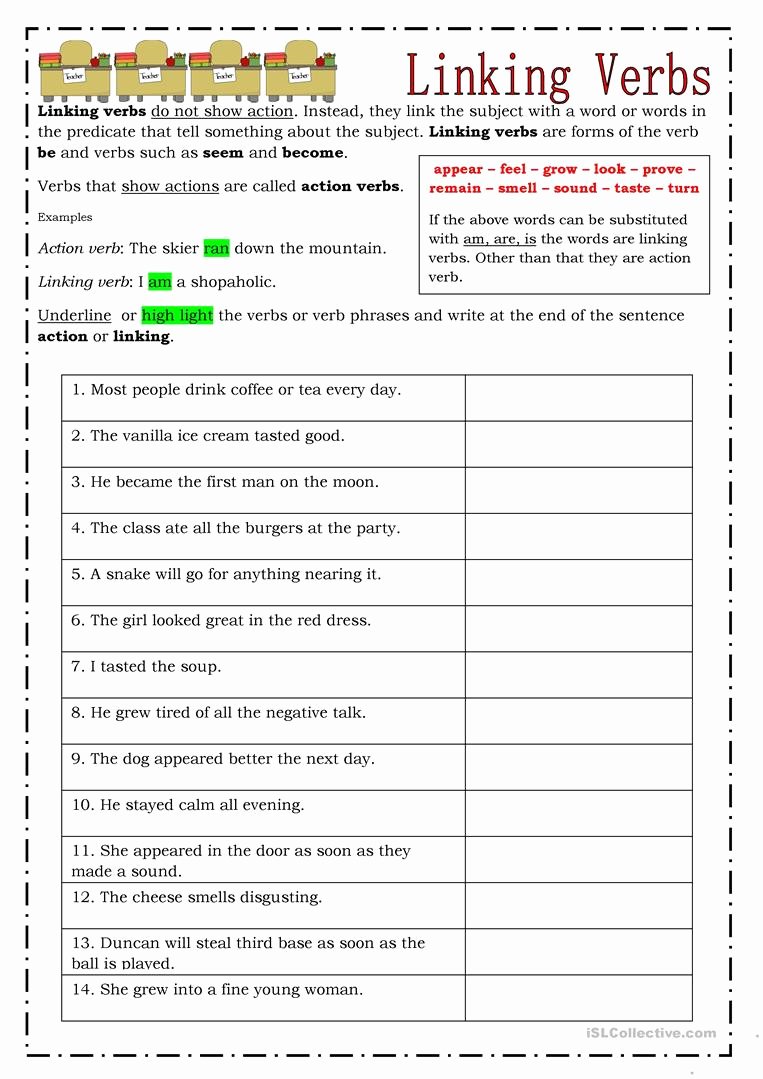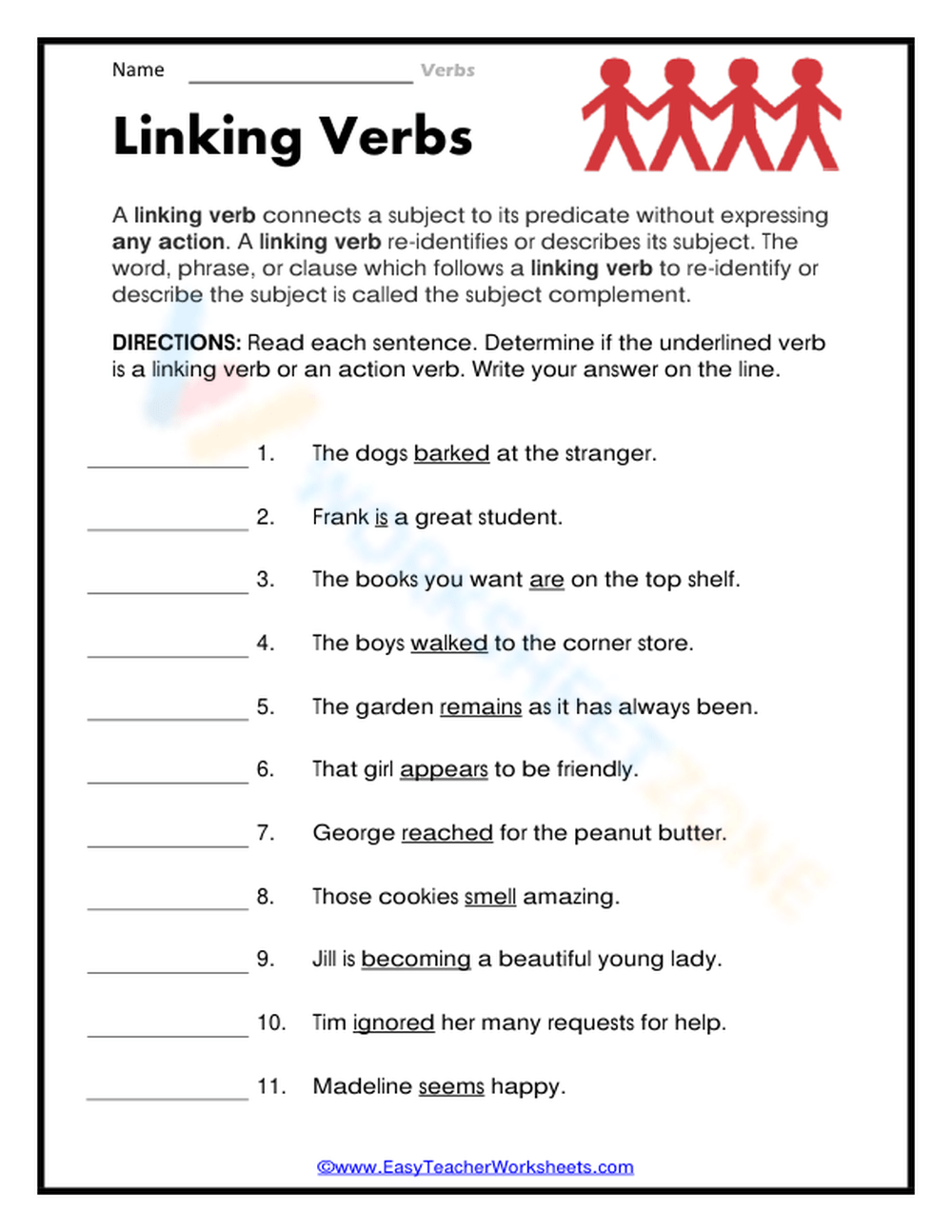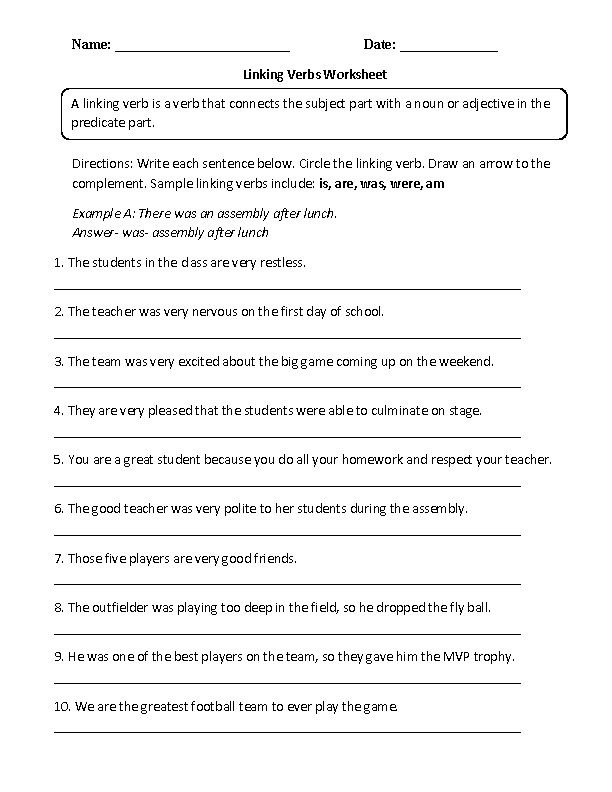
Mastering Grammar: The Indispensable Role of a Linking Verbs and Adjectives Worksheet
In the intricate tapestry of the English language, verbs and adjectives are two of the most fundamental threads. While action verbs propel narratives forward and adjectives paint vivid pictures, there exists a unique class of verbs that serves a different, yet equally crucial, function: linking verbs. These verbs do not express action but rather connect the subject of a sentence to a word or phrase that describes or identifies it. Understanding this connection, particularly the relationship between linking verbs and the adjectives that follow them, is paramount for clear, precise, and grammatically correct communication. And there’s no better way to solidify this understanding than through dedicated practice, often facilitated by a well-structured linking verbs and adjectives worksheet.
This article will delve into the essence of linking verbs and adjectives, explain their synergistic relationship, highlight common pitfalls, and ultimately demonstrate why a comprehensive linking verbs and adjectives worksheet is an indispensable tool for students, educators, and anyone aiming to refine their command of English grammar.

The Foundation: What Are Linking Verbs?

At its core, a linking verb acts as an equals sign between the subject and a word or phrase that renames or describes the subject. Unlike action verbs (e.g., run, jump, eat, write), linking verbs do not show an action performed by the subject. Instead, they establish a state of being, a condition, or an identity.

The most common linking verb is "to be" in all its forms: am, is, are, was, were, be, being, been.

Examples:

- She is a doctor. (Identifies the subject ‘She’)
- They were tired. (Describes the subject ‘They’)
- I am happy. (Describes the subject ‘I’)

Beyond "to be," other verbs can function as linking verbs, often relating to the senses or a state of existence:
- Verbs of Sense: feel, look, smell, sound, taste
- Verbs of Becoming: become, grow, turn
- Verbs of State/Condition: appear, seem, remain, stay, prove



Distinguishing Linking Verbs from Action Verbs:
It’s crucial to note that some of these verbs can also function as action verbs depending on the context. The key is to ask: Is the verb showing an action performed by the subject, or is it connecting the subject to a description or identity?
-
Linking: The soup smells delicious. (Describes the soup’s quality)
-
Action: He smells the flowers. (He performs the action of smelling)
-
Linking: She looks beautiful. (Describes her appearance)
-
Action: She looks at the painting. (She performs the action of looking)
Understanding this distinction is one of the first critical steps, and it’s a concept frequently targeted in a good linking verbs and adjectives worksheet.
The Descriptors: The Role of Adjectives
Adjectives are words that modify, or describe, nouns and pronouns. They provide more information about the qualities, characteristics, or states of the things they describe. Adjectives typically answer questions like: Which one? What kind? How many?
Examples:
- The red car. (What kind of car?)
- A tall building. (What kind of building?)
- The happy child. (What kind of child?)
When an adjective follows a linking verb, it is called a predicate adjective. The predicate adjective describes the subject of the sentence and is located in the predicate (the part of the sentence that contains the verb and tells something about the subject).
Examples of Predicate Adjectives:
- The sky is blue. (‘blue’ describes ‘sky’)
- He seems tired. (‘tired’ describes ‘He’)
- The music sounds loud. (‘loud’ describes ‘music’)
The Synergy: Linking Verbs and Adjectives Working Together
The magic happens when linking verbs and adjectives unite. A linking verb acts as the bridge that connects the subject to its descriptive adjective. Without this bridge, the sentence often loses its descriptive power or becomes grammatically incorrect.
Consider the common grammatical error: confusing adjectives with adverbs after linking verbs. Adverbs modify verbs, adjectives, or other adverbs, answering questions like How? When? Where? Adjectives, as we know, describe nouns/pronouns.
A frequent mistake is using an adverb when an adjective is required after a linking verb, particularly with verbs of sense.
Incorrect: I feel badly. (Unless you are describing your ability to feel with your fingers, "badly" is an adverb describing the action of feeling. If you mean you are not feeling well, you are describing your state of being.)
Correct: I feel bad. (Here, "bad" is an adjective describing the subject ‘I’.)
Incorrect: The food smells sweetly. (Unless the food is performing the action of smelling in a sweet manner, which is nonsensical.)
Correct: The food smells sweet. ("Sweet" describes the food.)
This specific area of confusion is a prime target for practice and reinforcement, making a focused linking verbs and adjectives worksheet invaluable. It helps learners internalize that linking verbs are followed by adjectives because they are describing the subject, not the action of the verb.
The Power of Practice: Why a Linking Verbs and Adjectives Worksheet is Essential
Theoretical understanding is one thing; practical application is another. A linking verbs and adjectives worksheet provides the structured environment necessary for learners to move from knowing what linking verbs and adjectives are to confidently using them correctly. Here’s why such a worksheet is so crucial:
- Reinforcement of Concepts: Repeated exposure to examples and varied exercises helps solidify the definitions and functions of both linking verbs and adjectives.
- Identification Practice: Worksheets often challenge students to identify linking verbs within sentences and then pinpoint the predicate adjectives they connect to the subject. This skill is foundational.
- Distinguishing from Action Verbs: Many exercises on a good worksheet will include sentences where verbs could be either linking or action, forcing students to apply the "action vs. state of being" test.
- Adjective vs. Adverb Choice: Perhaps the most common and beneficial exercise on a linking verbs and adjectives worksheet is the multiple-choice or fill-in-the-blank format that requires students to choose between an adjective and an adverb to complete a sentence containing a linking verb. This directly addresses the "feel bad/badly" type of error.
- Contextual Application: Worksheets present these grammatical concepts within the context of complete sentences, mimicking real-world language use rather than isolated word lists.
- Self-Assessment and Feedback: With an answer key, students can immediately check their understanding, identify areas of weakness, and learn from their mistakes. For educators, it provides a quick gauge of student comprehension.
- Building Confidence: Successfully completing a series of exercises on a worksheet builds confidence in a student’s grammatical abilities, encouraging them to apply these rules in their own writing and speaking.
Crafting an Effective Linking Verbs and Adjectives Worksheet
For educators designing their own materials or for learners seeking effective practice, a comprehensive linking verbs and adjectives worksheet should incorporate a variety of exercise types:
- Identification: Underline the linking verb and circle the predicate adjective in each sentence.
- Categorization: For a given list of sentences, identify whether the verb is an action verb or a linking verb.
- Fill-in-the-Blanks (Adjective/Adverb Choice): Provide sentences with a linking verb and two options (an adjective and an adverb) for the blank. (e.g., "She looks ___ (happy/happily).")
- Sentence Completion: Provide a subject and a linking verb, and ask students to complete the sentence with an appropriate predicate adjective.
- Error Correction: Present sentences with common errors (e.g., using an adverb instead of an adjective after a linking verb) and ask students to correct them.
- Creative Writing Prompts: Encourage students to write their own sentences using specific linking verbs and predicate adjectives.
The best worksheets progress in difficulty, starting with basic identification and moving towards more nuanced application and error correction. Clear instructions and an easily accessible answer key are also crucial for effective independent learning.
Beyond the Worksheet: Real-World Application
While a linking verbs and adjectives worksheet is an excellent tool for foundational learning, the ultimate goal is to apply these grammatical rules seamlessly in everyday communication.
- Improved Writing: A solid grasp of linking verbs and adjectives allows writers to craft more precise and descriptive sentences. Instead of simply stating facts, they can describe states of being and qualities, enriching their prose. "The room was quiet" is more evocative than just "The room had no sound."
- Enhanced Speaking: Avoiding common errors like "I feel badly" or "That sounds goodly" makes one sound more articulate and professional. Correct usage reflects a command of the language.
- Better Reading Comprehension: Recognizing linking verbs and predicate adjectives helps readers accurately interpret the relationships between subjects and their descriptions, leading to a deeper understanding of the text.
- Standardized Test Performance: Questions involving linking verbs and adjective/adverb choices are common on various English proficiency and standardized tests. Regular practice with a worksheet can significantly boost performance in these areas.
Conclusion
The relationship between linking verbs and adjectives is a cornerstone of English grammar, crucial for expressing states of being, qualities, and identities with clarity and precision. While seemingly simple, mastering this connection often requires targeted practice to overcome common pitfalls, particularly the confusion between adjectives and adverbs.
This is precisely where a well-designed linking verbs and adjectives worksheet proves its invaluable worth. By offering structured exercises that reinforce concepts, provide ample identification practice, and directly address common errors, these worksheets empower learners to internalize these rules. From basic identification to nuanced application, consistent engagement with such a resource paves the way for greater grammatical accuracy, leading to more confident and effective communication in both written and spoken English. Investing time in understanding and practicing with a comprehensive linking verbs and adjectives worksheet is an investment in linguistic mastery.
